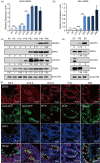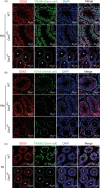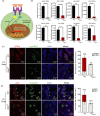RNA helicase DDX5 acts as a critical regulator for survival of neonatal mouse gonocytes
- PMID: 33666296
- PMCID: PMC8088469
- DOI: 10.1111/cpr.13000
RNA helicase DDX5 acts as a critical regulator for survival of neonatal mouse gonocytes
Abstract
Objectives: Mammalian spermatogenesis is a biological process of male gamete formation. Gonocytes are the only precursors of spermatogonial stem cells (SSCs) which develop into mature spermatozoa. DDX5 is one of DEAD-box RNA helicases and expresses in male germ cells, suggesting that Ddx5 plays important functions during spermatogenesis. Here, we explore the functions of Ddx5 in regulating the specification of gonocytes.
Materials and methods: Germ cell-specific Ddx5 knockout (Ddx5-/- ) mice were generated. The morphology of testes and epididymides and fertility in both wild-type and Ddx5-/- mice were analysed. Single-cell RNA sequencing (scRNA-seq) was used to profile the transcriptome in testes from wild-type and Ddx5-/- mice at postnatal day (P) 2. Dysregulated genes were validated by single-cell qRT-PCR and immunofluorescent staining.
Results: In male mice, Ddx5 was expressed in germ cells at different stages of development. Germ cell-specific Ddx5 knockout adult male mice were sterile due to completely devoid of germ cells. Male germ cells gradually disappeared in Ddx5-/- mice from E18.5 to P6. Single-cell transcriptome analysis showed that genes involved in cell cycle and glial cell line-derived neurotrophic factor (GDNF) pathway were significantly decreased in Ddx5-deficient gonocytes. Notably, Ddx5 ablation impeded the proliferation of gonocytes.
Conclusions: Our study reveals the critical roles of Ddx5 in fate determination of gonocytes, offering a novel insight into the pathogenesis of male sterility.
Keywords: DDX5; RNA-binding protein; gonocyte; spermatogonial stem cell; testis.
© 2021 The Authors. Cell Proliferation Published by John Wiley & Sons Ltd.
Conflict of interest statement
The authors declare no competing interests.
Figures






Similar articles
-
Cell-surface DEAD-box polypeptide 4-immunoreactive cells and gonocytes are two distinct populations in postnatal porcine testes.Biol Reprod. 2014 Apr 17;90(4):82. doi: 10.1095/biolreprod.113.114405. Print 2014 Apr. Biol Reprod. 2014. PMID: 24621921
-
Loss of Etv5 decreases proliferation and RET levels in neonatal mouse testicular germ cells and causes an abnormal first wave of spermatogenesis.Biol Reprod. 2009 Aug;81(2):258-66. doi: 10.1095/biolreprod.108.075200. Epub 2009 Apr 15. Biol Reprod. 2009. PMID: 19369650 Free PMC article.
-
DDX5 plays essential transcriptional and post-transcriptional roles in the maintenance and function of spermatogonia.Nat Commun. 2019 May 23;10(1):2278. doi: 10.1038/s41467-019-09972-7. Nat Commun. 2019. PMID: 31123254 Free PMC article.
-
Mammalian gonocyte and spermatogonia differentiation: recent advances and remaining challenges.Reproduction. 2015 Mar;149(3):R139-57. doi: 10.1530/REP-14-0431. Reproduction. 2015. PMID: 25670871 Review.
-
The Regulation of Spermatogonial Stem Cells in an Adult Testis by Glial Cell Line-Derived Neurotrophic Factor.Front Endocrinol (Lausanne). 2022 Jun 3;13:896390. doi: 10.3389/fendo.2022.896390. eCollection 2022. Front Endocrinol (Lausanne). 2022. PMID: 35721702 Free PMC article. Review.
Cited by
-
Molecular characterization, expression patterns and cellular localization of BCAS2 gene in male Hezuo pig.PeerJ. 2023 Oct 24;11:e16341. doi: 10.7717/peerj.16341. eCollection 2023. PeerJ. 2023. PMID: 37901468 Free PMC article.
-
Role of the DEAD-box RNA helicase DDX5 (p68) in cancer DNA repair, immune suppression, cancer metabolic control, virus infection promotion, and human microbiome (microbiota) negative influence.J Exp Clin Cancer Res. 2023 Aug 19;42(1):213. doi: 10.1186/s13046-023-02787-x. J Exp Clin Cancer Res. 2023. PMID: 37596619 Free PMC article. Review.
-
DDX5 Can Act as a Transcription Factor Participating in the Formation of Chicken PGCs by Targeting BMP4.Genes (Basel). 2024 Jun 26;15(7):841. doi: 10.3390/genes15070841. Genes (Basel). 2024. PMID: 39062620 Free PMC article.
-
E26 transformation-specific transcription variant 5 in development and cancer: modification, regulation and function.J Biomed Sci. 2023 Mar 6;30(1):17. doi: 10.1186/s12929-023-00909-3. J Biomed Sci. 2023. PMID: 36872348 Free PMC article. Review.
-
VASA protein and gene expression analysis of human non-obstructive azoospermia and normal by immunohistochemistry, immunocytochemistry, and bioinformatics analysis.Sci Rep. 2022 Oct 14;12(1):17259. doi: 10.1038/s41598-022-22137-9. Sci Rep. 2022. PMID: 36241908 Free PMC article.
References
-
- Saitou M, Barton SC, Surani MA. A molecular programme for the specification of germ cell fate in mice. Nature. 2002;418:293‐300. - PubMed
-
- Saitou M. Specification of the germ cell lineage in mice. Front Biosci (Landmark Ed). 2009;14:1068‐1087. - PubMed
-
- Anderson R, Copeland TK, Scholer H, et al. The onset of germ cell migration in the mouse embryo. Mech Dev. 2000;91:61‐68. - PubMed
-
- Ginsburg M, Snow MH, McLaren A. Primordial germ cells in the mouse embryo during gastrulation. Development. 1990;110:521‐528. - PubMed
MeSH terms
Substances
Grants and funding
- 2016YFA0100300/The Ministry of Science and Technology of the People's Republic of China
- XDA16010502/Strategic Priority Research Program of the Chinese Academy of Sciences
- XDA16020404/Strategic Priority Research Program of the Chinese Academy of Sciences
- 2016YFA0100400/The Ministry of Science and Technology of the People's Republic of China
- 31925009/National Natural Science Foundation of China
- 81902885/National Natural Science Foundation of China
- 32000424/National Natural Science Foundation of China
- 31871456/National Natural Science Foundation of China
- 2018GZR110104007/Key Research & Development Program of Guangzhou Regenerative Medicine and Health Guangdong Laboratory
- 2019B020234004/Science and Technology Planning Project of Guangdong Province, China
- 2020B1212060052/Science and Technology Planning Project of Guangdong Province, China
- 201906010096/Science and Technology Program of Guangzhou, China
- 2019A1515110028/Guangdong Basic and Applied Basic Research Foundation
- 2019B151502054/Guangdong Basic and Applied Basic Research Foundation
LinkOut - more resources
Full Text Sources
Other Literature Sources
Molecular Biology Databases
Research Materials

